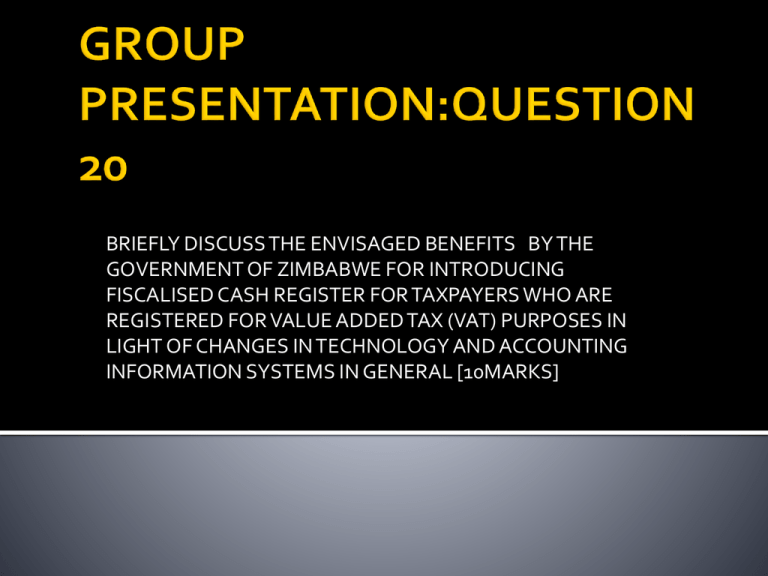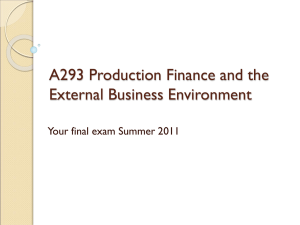grp-presentation-ais-q20
advertisement

BRIEFLY DISCUSS THE ENVISAGED BENEFITS BY THE GOVERNMENT OF ZIMBABWE FOR INTRODUCING FISCALISED CASH REGISTER FOR TAXPAYERS WHO ARE REGISTERED FOR VALUE ADDED TAX (VAT) PURPOSES IN LIGHT OF CHANGES IN TECHNOLOGY AND ACCOUNTING INFORMATION SYSTEMS IN GENERAL [10MARKS] A fiscalised cash tax register is an electronic cash register system with a fiscal memory, which is special Read Only Memory (ROM) built into the cash register to store tax information for up to three years at the point of sale. Value Added Tax (VAT) is that tax which is charged on the purchase price by the ZIMRA on behalf of the government.(In Zimbabwe 15%) a. b. Fiscalised cash register has the following features: A screen on which the customer can see simultaneously the input being made by the till operator printing sales slip for customers which can be retained for a period not less than three years c. fiscal memory of total daily sales d. An emergency back up power supply It must incorporate a back up audit facility and should be capable of being upgraded. a. Fiscalised cash tax registers have special features that cannot be tempered with. Each electronic tax register is identified by a single unique number assigned by the government and can record sales at the point of sale and store tax information for up to three years. They are thus placed to record VAT payable every period; hence they encourage transparency and fairness among taxpayers. b. The implementation of this new system will curb or reduce malpractices, manipulation and expose tax avoidance and invasions. In other words, this system is adopted to plug leakages on VAT. c. Fiscalised register are set to improve the collection of VAT by the Zimbabwe Revenue Authority (ZIMRA). This will go a long way in developing a functional and developmental country that is accountable. d. Fiscal receipts can easily be identifiable for inspection purposes and daily fiscal summary reports. This will help to minimize the number of tax defaulters in the retail sector and the new system will be able to close the net on defaulters. e. Minister Biti stressed that 20% would be realized from the country’s top 300 VAT contribution companies, and VAT collection would improve by 40% when the system is fully implemented across all sectors of the economy. f. Furthermore the system can store information up to 3 years whereby it shortens audit period by the taxman and also less paper work in the offices. It can also improve public procurement system. g. Ensures easy access of online tax information and quick response to deviation or malpractices over the machine. h. Minimize tax disputes and simplify tax refunds. i. Fiscalised cash tax register implemented by the government of Zimbabwe is one of the indispensible tools of Accounting Information System that enables the smooth flow of accounting data in the department of ZIMRA and a county as a whole. It is therefore a positive step in keeping abreast with technological changes and also in line with the accounting information system as a whole. However, the implementation of this system has some set becks that are associated with it. These include: a. There are a lot of software interfacing that is required and most companies have to comply with that. The hardware of this system might be incompatible with some of the retail operator system. More importantly, the exorbitant prices that are being charged of close to US$3000 make this system unaffordable by other firms. b. Installing new systems in companies becomes a disadvantage to the workers within the organizations hence affecting their morale. This is due to the fact that most people resist change and do not want to learn new things. This may also be so due to the fact that this requires computer literate workers hence a threat to their jobs. c. There are only two indigenous firms (Axis Solution and First Computers) that have approved and given tenders by the government to supply this system. These firms are failing to cope up with demand from firms and this is slowing the progress of the full implementation and therefore is dragging the benefits of this system to be realized. DISCUSS ANY TWO OF THE FOLLOWING FOUR BASIC TYPES OF SYSTEMS. CLOSED SYSTEM is a system that does not interact with the environment There are no interfaces. Has no effects on the outside of its boundaries and the environment has no effects on the process within the system. For example, a watch. It is a system which maintains itself on a limited amount of resources that are firmly established in that particular system hence being difficult to change it. Such a system is a theoretical concept rather than being a practical concept. EXAMPLE Certain departments within an organisation can be set up as closed system. A research and development (R&D) department within a computer organisation may be set up as a closed system with no interaction outside the division. The purpose is to protect trade secretes and invention that are being produced inside. ADVANTAGES There are no disturbances in the system. It is highly effective and efficient. LIMITATIONS Can hamper growth since the flow of information stays within the system. Has no chance to interact with or build on knowledge from the outer world. It does not adapt to technological changes. It practically does not exist because it lacks the need for interaction. RELATIVELY CLOSED SYSTEM It reacts with its environment in a known and controlled way. The interactions consist of system inputs (if they flow from the environment to the system) and outputs (which are interactions flowing in the opposite direction) The system contains interfaces with the environment and controls the effects of the environment on its process. RELATIVELY CLOSED SYSTEM It interacts with its environment in a restricted way that does not eliminate but limits its susceptibility to the environment. For example, labour negotiations can limit the effects of strike. It is semi permeable. ADVANTAGES Able to meet user needs as they are able to take inputs for development purposes. It is flexible – adapts to technological changes. It allows for a reasonable level of sharing and exchange of information. Minimises the impact of disturbances as there are control measures. DISADVANTAGES It is not reliable – for it is prone to disturbances from the environment Is one in which the systems interaction with the environment is not controlled. Has many interfaces with its environment ,that is ,system that interacts freely with its environment, taking input and returning output. Contains subsystems which help in converting input into output. It permits interactions across its boundary , it receives inputs from and delivers outputs to the outside. System designers anticipate the things that can go wrong in the environment and create processes and interfaces to control them. For example, media and internet. Have flexible boundaries since it interacts with the environment. Promote effective problem solving. Subsystems help in resolving conflicts as well as allocating resources. The system has disturbances of uncontrolled inputs that affect the processed resources within the system. A portion of the system is retained as an input to the system. For example, in accounting system ,revenue output by other goods can be used as capital in costing and variances can be output that can be used in decision making. Designed to provide feedback Uses interfaces to permeate information bottom up and top down. Uses the function of a prescribed relationship between the output and reference input to control the process of resources in that system. The difference between the output of the process under control and the reference input is amplified and used to control the process so that the difference is continuously reduced Can be used for decision making. Provide the feedback which help the system to obtain its goals and enhance employee motivation. Provide management with meaningful information on how effective its planning effort was. The effect of unwanted disturbances can be effectively reduced. The time the manager may get the information , the damage might already have been done thus making feedback irrelevant It is expensive to set up and the cost of feedback is first manifested in the increased number of components and the complexity of the system.











